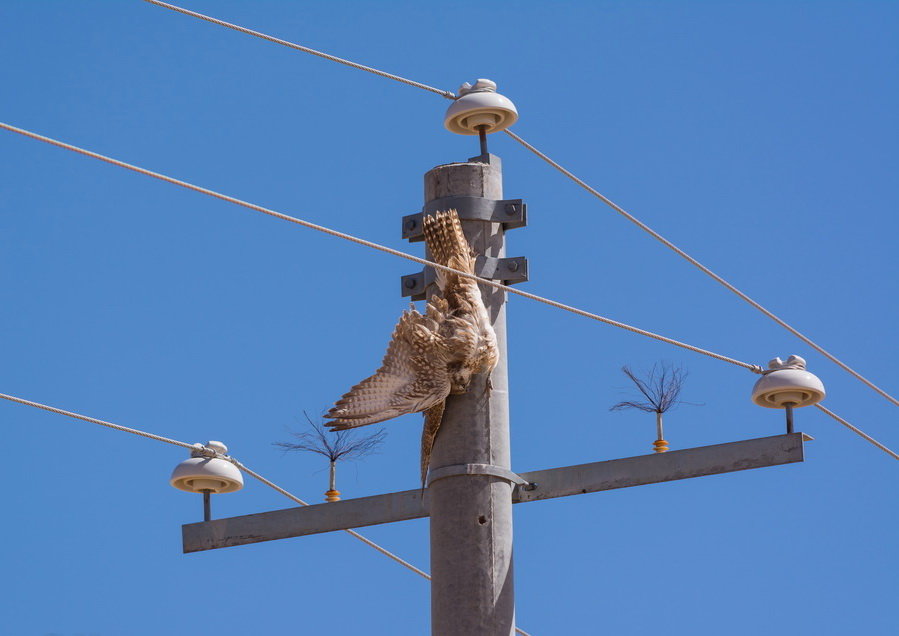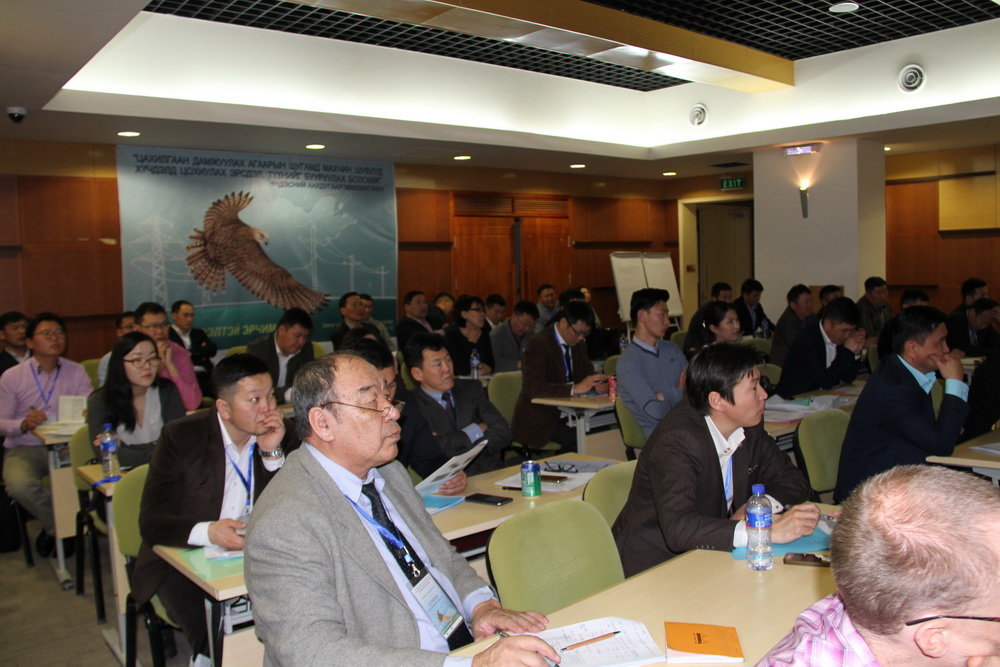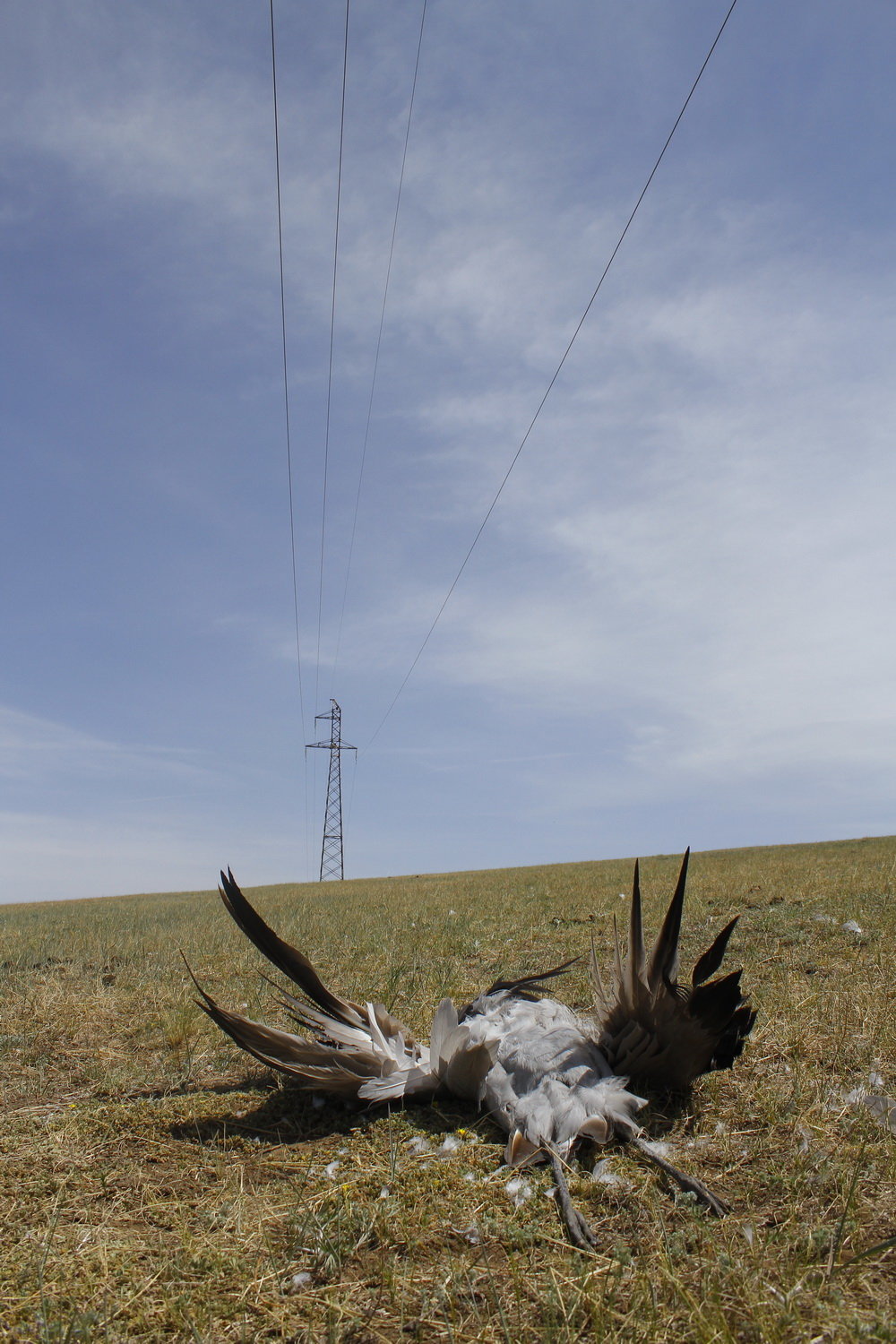Avian mortalities from powerlines
Electrocution
Perhaps, at the moment, Mongolia holds the record of one of the worst raptor electrocution accounts in the world. Every year, thousands of birds of prey and many other species are dying due to electrocution mostly on medium voltage electricity transmission lines throughout Mongolia. Over half of the electrocuted birds is the Saker Falcon which is a national bird of Mongolia. It has been estimated that between 800-4000 saker falcons are being electrocuted each year in Mongolia.

Electrocution in the Mongolian steppe is resulted from birds contacting live conductor cables either when perched at the top of the grounded steel-reinforced concrete pole or when perched on the steel crossarm.
A faulty design approved by government agencies and lack of government regulations to ensure safety of birds and transmission lines are to blame for this massive scale raptor electrocution in Mongolia. Unfortunately, the problem is not a local issue, it is a nationwide problem for conservation and the cost of fixing it going to be a huge burden on the economy.
We have been most active working with both national and international stakeholders to raise awareness of the issue and conducted trials of mitigation techniques aimed at reducing avian electrocution rates in the steppe. In March 2017, we organized first national workshop on raptor electrocution in Ulaanbaatar bringing together power line engineers, conservation organizations, and scientists to discuss the issue. Participants delivered a series of recommendations to the government for actions. Eventually, much needed support became available from different sources and many important actions are being taken at all level.

Now with our collaborating partners, we are monitoring the impact, increasing awareness of the issue among stakeholders, conducting trials of mitigation methods for existing lines, developing national standards and guidelines on avian friendly powerlines, and identifying potential risks to prevent further problems. Several most high risk lines have been mitigated using an inexpensive method in two provinces in Mongolia with an average reduction of 85-90%. Our ultimate goal is to eliminate the raptor electrocution in the Mongolian steppe.
At the BirdLife Global Summit that was held in Abu Dhabi in April 2018, HE Mohammed Al Bowardi, the managing director of the Environment Agency of Abu Dhabi announced that Mohamed Bin Zayed Raptor Conservation Fund pledges USD 1 mln to tackle electrocution problem in Mongolia. Later, a MoU was signed in Abu Dhabi on 27 February 2019 by Majid Al Mansouri, Managing Director of MBZRCF, and Mr. Tserendorj Batbayar, Vice Minister of the MET in the presence of Ambassador Chintushig Zorigt. The Vice Minister Batbayar said the project will be a key to stop this mass electrocution in Mongolia.
Collision with overhead wires
Avian collision with power lines is well documented phenomenon worldwide and it is estimated that the bird fatalities due to colliding with power structures, including transmission and distribution lines, could reach several billion annually.
As Mongolia's energy sector and their associated infrastructure grows, potential threats to birds are increasing as well. Especially the risk of birds to collide with overhead wires are exponentially growing every year because the power grids are expanding linking towns, businesses, and new mine sites in rural areas. Mongolia is home to many large and threatened birds such as Great Bustard, Houbara Bustard, Cinereous Vulture, Golden Eagle, Steppe Eagle, and several species of cranes that might significantly be impacted from energy sector expansion.
Unfortunately, a very little is known about status of avian collision rate with power lines in Mongolia. Available information indicate that the avian collision risk and mortality related to medium and high voltage lines in Mongolia are underreported and can be potentially high to certain species and regions.
Additional information:
Dixon et al. 2013. The problem of raptor electrocution in Asia: case studies from Mongolia and China, click here
Dixon et al. 2017. Avian electrocution rates associated with density of active small mammal holes and power-pole mitigation: Implications for the conservation of Threatened raptors in Mongolia, click here
Dixon et al. 2018. Efficacy of a mitigation method to reduce raptor electrocution at an electricity distribution line in Mongolia, click here
Emirates News Agency. 2018. Mohamed bin Zayed establishes Raptor Conservation Foundation, click here

